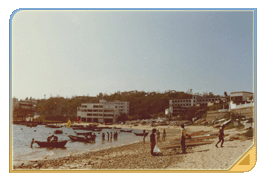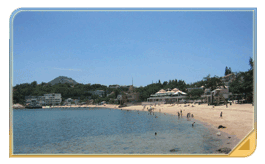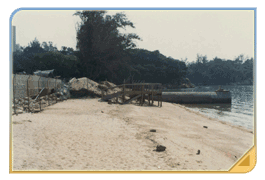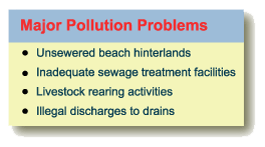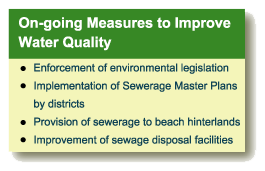| Overview |
 |
|
|
|
 |
Stanley Main Beach in the early 1980s (above)
and in 2005 (below)
|
|
Most of the thousands of Hong Kongers who basked on Hong Kong's
beaches and swam in its clear waters in 2005 were probably unaware
that, just twenty years ago, many of our beaches would have been
off-limits to them. The early 1980s were a time of rapid and often
unbridled urban expansion, and our environment¡Xincluding the seas
and beaches around Hong Kong's coastline¡Xwas suffering as a result.
Faced with deteriorating beach water quality and more and more
of Hong Kong's beautiful beaches becoming 'no-go' areas for recreation
and exercise, in 1986 the Government first placed the Environmental
Protection Department in charge of its Beach Water Quality Monitoring
Programme. In this, its twentieth anniversary year, we are taking
the opportunity to highlight the changes and achievements of the
past two decades, placing the beach water quality of 2005 in the
context of twenty years of work by the EPD.
When the EPD first took over the Beach Water Quality Monitoring
Programme in 1986, it devoted much thought to defining the aims
and requirements of the Programme. Two key needs were recognised.
First, scientific rigour in the assessment of water quality was
essential. How could the EPD know the best steps to take without
hard scientific evidence of the nature and extent of beach water
pollution in Hong Kong? The EPD realised it would need to develop
a scientifically sound set of water quality objectives. It would
need to conduct epidemiological studies that could establish clear
relationships between bacteria in the water and the specific health
risks associated with swimming at beaches in Hong Kong.
|
|
|
| |
Drainage diversion work at Cheung Chau
Tung Wan Beach in 1989
|
|
Secondly, the EPD recognised that substantial
improvement in water quality would require concerted, long-term
actions. These would involve activities as varied as tackling
the discharge of pollution in beach catchment areas, providing
proper sewerage facilities to areas in the hinterland of beaches,
diverting or extending sewage outfalls, controlling waste disposal
from livestock and other pollution sources, and taking localised
remedial action wherever necessary. Some of these actions could
be undertaken by the EPD itself, while others would involve collaboration
with other Government Departments or authorities.
The EPD has been doing these key tasks for two decades now,
and over that time has developed an accurate and efficient beach
water quality monitoring system that utilises the latest and
the best in technology and scientific knowhow. After many years
of honing and improvement at many levels, the Programme has now
reached maturity. The vigorous scientific work that underpins
the Programme has been published in international journals and
has been well recognised by organisations such as the World Health
Organization (WHO). The BBC news has also reported on how the
EPD's beach monitoring programme has become a leading model for
South East Asia. In addition to the technical part of its job,
the EPD has also taken responsibility for making information
available to the Government, academics and the general public
in an accessible, clear, and up-to-date way. Its Annual Reports
are one of the methods used by the EPD to pass on the monitoring
information it gathers over the year.
|
|
|
|
|
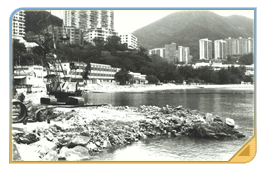
 |
Repulse Bay - Sewerage works carried out in
the late 1980s
|
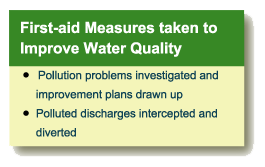
|
The EPD quickly initiated a number of emergency measures to bring the
situation at the worst-affected beaches under control. These 'first-aid'
measures included diverting polluting stormwater drains away from Repulse
Bay, Middle Bay, Deep Water Bay, Shek O and Chung Hom Kok beaches, a
measure that had an immediate and dramatic impact on beach water quality
there. Sewage pumping facilities were installed to carry waste water
to treatment plants: for example, pumping facilities at the Repulse Bay
Chlorination Plant were completed in 1989, reducing bacterial levels
in the waters of Repulse Bay. More generally, the EPD channelled many
resources into investigating major pollution problems, planning sewage
infrastructure, and instigating improvement works wherever possible.
The EPD also involved itself actively in introducing anti-pollution
laws and related measures. The Livestock Waste Control Scheme came into
force in June 1988, and the EPD made sure its provisions were widely
understood and implemented by farmers, especially in areas close to beaches
such as Silver Mine Bay and Angler's Beaches. It has also been enforcing
the Water Pollution Control Ordinance, which has been introduced to different
regions of Hong Kong in phases. This has enabled the EPD to tackle many
sewage pollution problems at source, placing the liability on land and
factory-owners to stop harming the environment.
|
| |
Longer term, the EPD plans and helps implement the
Government's Sewerage Master Plans, a series of plans extending sewerage
systems for each district and laying out proposed new sewage disposal facilities.
At a local level the EPD has worked in collaboration with other Government
Departments at individual beaches, leading to improvements such as the
provision of new non-polluting beach facilities and toilet blocks at beaches
like Kwun Yum Wan, Cheung Chau Tung Wan, and Tong Fuk.
|
|
 |
|
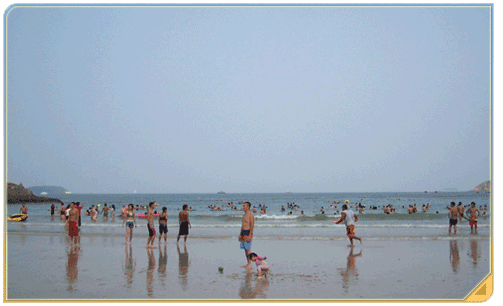
| |
Clean water and clear skies greet swimmers at Shek
O Beach |
|
| |
|
By 2005, major changes had taken place that had transformed
beach water quality for many of Hong Kong's beaches. Gone were most of
the heavily polluting sewage outflows from dense residential developments,
the waste from farms, and the contaminated stormwater drains. For some
areas of Hong Kong, such as the beaches on the south of Hong Kong island,
the difference has been especially dramatic, with beaches that were once
heavily polluted now safe playgrounds for swimmers all year round. By
comparison with the 11 'Good' beaches of 1986, in 2005 a total of 23
beaches had water quality assessed as 'Good'.
|
| |

| |
At the beach: fun and exercise for all ages
|
|
Although there remains work to be done in improving
our beach water quality, much has been achieved over the past twenty
years. The majority of Hong Kong's beaches in 2005 offered visitors safe,
enjoyable environments for swimming, playing, or just lying on the sand.
The confidence the public has in our beaches was reflected in the number
of visitors, with records showing that over a million visits a month
were made to beaches during the 2005 bathing season.
|
| |
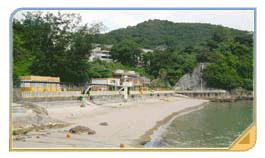
| |
Silverstrand Beach opens year-round to swimmers
|
|
In fact, the main problem faced by keen beachgoers in 2005 was one outside
the control of the EPD¡Xrain! The summer of 2005 was exceptionally wet,
with rainfall levels 53% higher than the average rainfall for this period
and almost double that of 2004. Despite this exceptional rainfall across
the summer however, the year showed up the strengths of Hong Kong's beaches
well. Most beaches remained open, and water quality was by and large
good. Improvements in water quality at Silverstrand Beach in Sai Kung
District showed the indisputable benefits of public sewerage systems.
New improvements to safety were implemented: for example, all gazetted
beaches now have shark nets installed, after nets were added at Cafeteria
Old Beach and Lower Cheung Sha Beach midway through the swimming season
in 2005. Best of all, 2005 saw the re-opening of a beach that had been
closed for 24 years, Castle Peak Beach in Tuen Mun District. This beach,
discussed in detail later in this report, is a splendid example of what
can result from concerted efforts in pollution control, water monitoring,
and a commitment to positive change in the environment.
Most of the beaches in Tsuen Wan District remained problematic and stayed
closed in 2005 while steps continue to be taken to improve their water
quality and prepare them for re-opening in the future. These include
local sewerage schemes to ensure sewage from nearby properties can be
intercepted and removed for treatment rather than polluting the nearby
beaches. They also include a plan to disinfect the very large discharge
from Stonecutters Island, subject to the public's willingness to meet
the operating costs through increased sewage charges. Nevertheless the
EPD is optimistic that provided the public is willing to pay its share
of the costs of sewage treatment, further work over the next few years
will see all Hong Kong's gazetted beaches once again open for swimming.
|
| |

| |
Tropical paradise? Lower Cheung Sha Beach |
|
|
|
|
|


